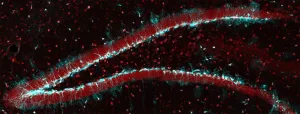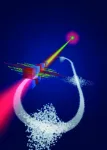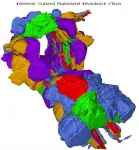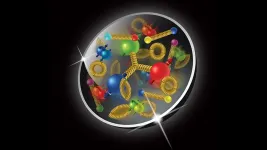(Press-News.org) In the last 60,000 years, humans have emerged as an ecologically dominant species and have successfully colonized every terrestrial habitat. Our evolutionary success has been facilitated by a heavy reliance on an ever-advancing technology. Understanding how human technology evolves is crucial to understanding why humans have enjoyed such unprecedented evolutionary success.
ASU doctoral graduate Jacob Harris, working with ASU researcher Robert Boyd and Brian Wood from the University of California Las Angeles and the Max Planck Institute for Evolutionary Anthropology, are interested in the role of causal knowledge in the manufacture, transmission, and ultimately, the evolution of technology. Causal knowledge is the ability to predict the effect of an intentional modification of a system, like the design and manufacture of traditional bow-and-arrow technology -- the focus of their investigation.
Prior research on causal knowledge has been restricted to theoretical work and experiment studies with student participants. Harris and Wood lived and worked with Hadza hunters for several months and interviewed them about bow manufacture and use. The Hadza are contemporary hunter-gathers who live in north-central Tanzania. There are currently around 1,200 speakers of the Hadza language distributed across a wide region, with local groups varying in the total fraction of their diet that is derived from hunting and gathering. However, even among those groups that forage the least, the manufacture and use of bow and arrow technology is a vibrant and daily practice among men.
The research, published this week in the journal Current Biology, addresses two competing theories in human evolution. The cognitive niche hypothesis proposes that innovations typically arise and are then refined over the course of a single lifetime, rather than generations, and if environments change people rapidly adapt. Proponents of this hypothesis argue that innovation and transmission require causal understanding. The cultural niche hypothesis holds that cultural elements often accumulate and recombine without a causal understanding by those who use them.
Hadza bowyers (bow makers) provide a rare opportunity to evaluate these models in a naturalistic setting involving one of the most significant technologies in human evolution -- the bow and arrow.
Harris and Wood interviewed 64 highly skilled Hadza bowyers between the ages of 15 and 77 from five different camps regarding bow manufacture and use. Subjects were asked questions about their bows and asked to predict how minor modifications would affect either arrow speed or noise production. Queries included questions such as, "Will an increase in draw weight (strength of pull) result in the arrow traveling faster, slower, or no change?" and "Will an increase in brace height -- the distance from the bowstring to the inside of the bow -- result in the arrow traveling faster, slower, or no change?"
"When making a bow, the bowyer confronts a series of complex trade-offs, and his design choices represent one possible solution out of a large number of possibilities," said Harris. "The Hadza bow represents an elegant solution to an exceptionally complex optimization problem. Their bows are extremely versatile, capable of killing a wide range of prey and functioning in a variety of environments." Harris conducted this research while a postdoctoral researcher at the University of California, Los Angeles.
The research findings suggest that the Hadza study participants are able to manufacture and transmit bow-making technology with only partial causal knowledge. It appears that some of the design choices made by Hadza bowyers are constrained by cultural norms rather than a desire to optimize performance. They also found that causal knowledge does not correlate with age. In other words, individuals don't appear to acquire a more complete causal schema as they grow older.
"Hadza bowyers construct powerful bows from local materials and use them to hunt a wide variety of prey. Over 95% of Hadza men possess a bow, and hunters use their bows to provide the majority of the meat in their diet and therefore, represent a vital aspect of the Hadza economy," said Wood. "Hadza men begin using bows at a very early age. Boys as young as three years old mimic the manufacturing behaviors of their elders and begin manufacturing their own bows. By early adulthood they are highly proficient bowyers and hunters."
There is also no evidence that some individuals are significantly more knowledgeable than others. Prior research reported the presence of socially acknowledged "experts" in areas such as hunting, honey gathering, and arrow making. However, bow-making skill, as perceived by Hadza bowyers, does not appear to be predicated on exceptional cause-and-effect knowledge of bow mechanics.
"The evolution of complex technologies, such as the bow, can occur with only partial causal understanding and has significant implications for our understanding of the cultural evolution of technology. It suggests that the human proclivity to rely upon cumulative culture rather than individual expertise likely has deep evolutionary roots," said Boyd, professor in the School of Human Evolution and Social Change and research affiliate with the Institute of Human Origins.
"A more holistic understanding of technological evolution is necessary, one that does not view these two competing models as mutually exclusive. In our study, we found evidence to suggest that a complete causal understanding is not necessary, but we also identified key aspects of Hadza projectile technology that were more likely to be associated with causal knowledge," said Harris.
The researchers will continue their investigation into which aspects of this technology are more likely to be associated with and without causal knowledge and explore the degree to which these are learned though experience and/or through direct (active teaching) or indirect (observation) transmission. Their research will contribute to the development of a more holistic theoretical model that accounts for the relative roles of multiple influences, including culture, causal knowledge, and environmental constraints such as resource availability.
INFORMATION:
This research was published as "The role of causal knowledge in the evolution of traditional technology," in Current Biology, Jacob A. Harris, Robert Boyd, Brian M. Wood.
What The Study Did: This study combined the results of 12 studies with 1.8 million participants to examine the association between attention-deficit/hyperactivity disorder (ADHD) in childhood and adolescence and the subsequent risk of developing a psychotic disorder.
Authors: Mikaïl Nourredine, M.D., M.Sc., of the Hospices Civils de Lyon in Lyon, France, is the corresponding author.
To access the embargoed study: Visit our For The Media website at this link https://media.jamanetwork.com/
(10.1001/jamapsychiatry.2020.4799)
Editor's Note: The article includes conflict of interest disclosures. Please see the article for additional information, including other authors, author contributions and ...
BOSTON (February 24, 2021) - Results of a study published today in JAMA Surgery reveal the impact post-operative delirium has on health care costs in the U.S. Data from the study shows that if delirium were prevented or made less severe for patients, it could reduce health care costs by $33 billion per year, that is, $44,300 per patient per year. Severe delirium resulted in an additional $56,500 per patient per year, as compared to routine health care costs for older post-operative patients.
Tammy Hshieh, M.D., M.P.H., Adjunct Scientist, and Ray Yun Gou, M.A., Data Scientist II, both with the Aging Brain Center in the Hinda and Arthur Marcus Institute for Aging Research at Hebrew SeniorLife, are co-first authors. Sharon K. Inouye, M.D., M.P.H., Director ...
CHAPEL HILL, N.C.--For the last decade, the U.S. Food and Drug Administration has required tobacco manufacturers and importers to report the levels of harmful and potentially harmful chemicals found in their tobacco products and tobacco smoke. The idea was to educate the public and ultimately to decrease tobacco use, but little research has demonstrated if such information can impact on people's decisions to quit smoking.
A new study from the University of North Carolina at Chapel Hill has found that smokers who saw messages about tobacco chemicals with associated ...
The stem cells in our brain generate new neurons throughout life, for example in the hippocampus. This region of the brain plays a key role for a range of memory processes. With increasing age, and in patients suffering from Alzheimer's disease, the hippocampus' ability to create new neurons declines steadily - and with it, its memory functions.
Distribution of age-dependent cell damage
A study conducted by the research group of Sebastian Jessberger, a professor at the Brain Research Institute of the University of Zurich, shows how the formation of new neurons is impaired with advancing age. Protein structures in the nuclei of neural stem cells make sure that harmful proteins accumulating ...
The most modern light sources for research are based on particle accelerators. These are large facilities in which electrons are accelerated to almost the speed of light, and then emit light pulses of a special character. In storage-ring-based synchrotron radiation sources, the electron bunches travel in the ring for billions of revolutions, then generate a rapid succession of very bright light pulses in the deflecting magnets. In contrast, the electron bunches in free-electron lasers (FELs) are accelerated linearly and then emit a single super-bright flash of ...
Researchers have mapped the physical organization of the brain of a microscopic soil-living nematode worm called Caenorhabditis elegans, creating a new model for the architecture of the animal's brain and how it processes information.
In a surprise twist, they found a large degree of variation in the structure of some neural circuits or pathways in individual worms which complemented a core set of neural circuits common to different animals.
The scientists say the worms' brains might have a lot more in common with larger animals than previously thought.
Created by neuroscientists at the University of Leeds in collaboration with researchers in New York's Albert Einstein College of Medicine, the brain map reveals that ...
Scientists at the Children's Medical Center Research Institute at UT Southwestern (CRI) have identified the specialized environment, known as a niche, in the bone marrow where new bone and immune cells are produced. The study, published in Nature, also shows that movement-induced stimulation is required for the maintenance of this niche, as well as the bone and immune-forming cells that it contains. Together, these findings identify a new way that exercise strengthens bones and immune function.
Researchers from the Morrison laboratory discovered that forces created from walking or running are transmitted from bone surfaces along arteriolar blood vessels into the marrow inside bones. Bone-forming ...
A study of spatial learning in mice shows that exposure to new experiences dampens established representations in the brain's hippocampus and prefrontal cortex, allowing the mice to learn new navigation strategies. The study, published in Nature, was supported by the National Institutes of Health.
"The ability to flexibly learn in new situations makes it possible to adapt to an ever-changing world," noted Joshua A. Gordon, M.D., Ph.D., a senior author on the study and director of the National Institute of Mental Health, part of NIH. "Understanding the neural basis of this flexible learning in animals gives us insight into ...
Asymmetry in the proton confounds physicists, but a new discovery may bring back old theories to explain it.
Symmetry -- displayed in areas ranging from mathematics and art, to living organisms and galaxies -- is an important underlying structure in nature. It characterizes our universe and enables it to be studied and understood.
Because symmetry is such a pervasive theme in nature, physicists are especially intrigued when an object seems like it should be symmetric, but it isn't. When scientists are confronted with these broken symmetries, it's as if they've found an object with a strange reflection in the mirror.
"Nature is leading the way for concepts in older models of the proton to get a second look." -- ...
UCLA materials scientists and their colleagues have developed a new method to make synthetic biomaterials that mimic the internal structure, stretchiness, strength and durability of tendons and other biological tissues.
The researchers developed a two-pronged process to enhance the strength of existing hydrogels that could be used to create artificial tendons, ligaments, cartilage that are 10 times tougher than the natural tissues. Although the hydrogels contain mostly water with little solid content (about 10% polymer), they are more durable than Kevlar and rubber, which are both 100% polymer. This kind of breakthrough has never been achieved in water-laden polymers until this study, which was recently published in Nature. ...






